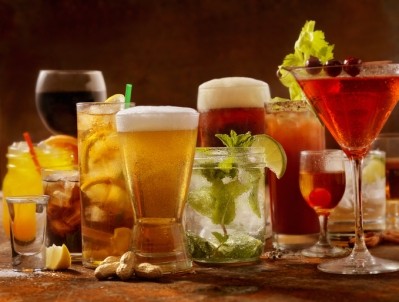Could AI take the place of winemakers and brewers?

AI is growing: leaving no industry untouched. It's increasingly being turned to to solve challenges in formulation, production, and more.
It's already being used extensively in wine and beer making: take, for example, technology that controls irrigation of vineyards or monitors brewing conditions for beer.
And yet the wine and beer industries are a little different from others. They have thrived, for centuries, on the know-how of experts. It's all very well using AI to measure conditions or optimize production - but what about when it comes to tasting and testing and analyzing complex flavors and aromas?
Can beermakers and winemakers - who often consider their jobs more of an art than a science - use AI? Could it help their roles - or take them over entirely?
'E-tongue' beats humans in wine tests
In the wine industry, a new 'e-tongue' is making waves. The instrument is equipped with an array of seven cross-selective chemical sensors that can detect overall changes in all soluble organic and inorganic compounds in liquid matrices.
That essentially mimics the areas that humans can taste.
But how does the e-tongue measure up to human winemakers?
Researchers from the Washington State University recently put the question to the test: seeing which could detect microbial spoilage first.
In a study that pitted an e-tongue against a human sensory panel, the researchers found that the e-tongue detected taste changes on day 7 of storage of a Reisling wine over 42 days of storage, while the panel couldn’t perceive significant differences between spoiled and control wine until day 35.
One of the biggest wins for the AI was that it did not suffer from ‘sensory fatigue’ in the same way humans do.
“Sensory fatigue occurs when many samples are assessed and [human] sensitivity is affected,” explained Carolyn Ross, PhD, member of Institute of Food Technologists and professor of Food Science at Washington State University, and one of the researchers.
“In the case of sensory evaluation of a large number of products, this decrease in sensitivity generally means that individuals decrease in their ability to detect differences or changes in products.
"For example, if someone has to assess 100 red wine samples over a short time, by the time they get to sample 50, they are likely not as sensitive to some of the sensory properties of the wine as they were with sample 1.”
Her study chose to look at microbial spoilage because this represents a very real need for winemakers where AI could help. Early detection of microbial spoilage allows winemakers to identify and minimize the progression of problematic metabolites: allowing them to correct future quality faults before they happen.
“If wine faults are detected early, there are several options for early remediation to stop the organisms from continuing to grow," said Ross. "This also provides time to determine next steps – does the wine need to be discarded thus freeing up resources? Or does the wine need to be diluted to a concentration where the wine fault is not detected?”
Despite the success of the e-tongue in the study, Ross does not see the AI taking over from winemakers any time soon. That’s because of the complexity of the liquid.

“The e-tongue cannot replicate the complexity of the human sensory systems which integrates so many different facets of the wine, including aromas, non-volatile taste compounds, mouthfeel (like astringency and ethanol burn), to provide an overall assessment,” she said.
“I think that with time, the electronic tongue along with many other measurements of the wine could be used to build models to predict sensory response (using AI) but I still think that it will not actually replace sensory assessment.”
But that does illustrate how the tool could be complementary. Think, again, about the example of sensory fatigue.
“What the electronic tongue would allow is an assessment of all the samples and then a smaller sub-set could be selected and forwarded for sensory assessment,” explains Ross. “So in this way, the e-tongue does not replace sensory testing rather is complements it.”
Brewing up the future
In beer, researchers are using AI to assess and characterize different styles of beer.
As with wine, it's a highly subjective beverage. And guides often resort to general descriptions such as 'fruity' or 'bitter'.
Scientist from VIB-KU Leuven Center for Microbiology and the Leuven Institute for Beer Research in Belgium have been using AI to create a clearer and more accurate way of describing beers.
As with the wine e-tongue, the information can then be used to improve the beer: looking at what aroma compounds can be added to create new or better flavors. That might be modifying the concentrations of major volatiles, such as esters, diacetyl, alcohol and hop and malt aromas.
The researchers chemically analyzed beers, measuring the concentrations of hundreds of aroma compounds. That was accompanied by an evaluation by a trained panel of 15 people, who were asked to comment on a set of 50 criteria.
Once they had the chemical concentrations and detailed tasting reports for hundreds of different beers, scientists then turned to AI to connect the two. One model could predict key aromas and the final appreciation score of a beer, without the need for human tasting.
These outcomes, in turn, were used to further improve the taste of an existing commercial Belgian ale, by adding certain aromas predicted by the model to boost the beer’s quality. The modified beer scored better in blind tastings than the original version.
But despite the AI's success, Kevin Verstrepen of Belgium’s VIB-KU Leuven, does not believe it's a replacements for brewmasters.
"No, I don't think AI will replace brewers - or consumer tests of beer - any time soon," he said.
"Our models make a link between the chemical composition and consumer perception and appreciation. We tested this by spiking commercial existing beers with complex mixtures of aroma compounds predicted by the AI model to make the beer even better. And it works!"
However, beer is very much about the purity of its four raw materials, and 'spiking' beer with additives is not common practice. And it's still down to brewmasters to create the desired changes through the brewing process - such as by changing the ingredients, brewing process or fermentation conditions.
But the AI has shown what is possible: because it gives brewers so much knowledge about the aroma compounds in beer and their origins
"In principle, AI could also be used to train an “artificial brewer”, but that would required making hundreds or thousands of different brews, each with different ingredients and brewing schemes, and then tasting all these," he said. "That would then enable AI to learn what good recipes are and tweak them.
"So, for now, I see more of a role for AI as a tool for brewers that can help them to tweak existing beers and make these even better."
It's not just beer and wine where the skill of a human is critical.
Orange juice brand Tropicana has insured its Master of Orange's tastebuds for £1m: saying they are just as rare and critical as those of a sommelier.
As a 'supertaster' - where a person experiences flavors and aromas of any given food more intensely - Nathalie Leenknecht is tasked with selecting the best oranges and varieties and then ensuring consistency across the brand.
Beer, wine and beyond
The Washington State University researchers and the Leuven Institute for Beer Research have used AI to address very specific needs in the wine and beer industries.
But the Washington State University team has also explored the e-tongue in a number of beverages and scenarios. Its analysed wine faults in red wine, differences in beer composition, and difference between apple varieties in cider.
This has then been broadened out to other food and beverage applications. "We have used this for sweeteners (to distinguish sucrose from non-nutritive sweeteners), cheese (to track aging), spicy compounds (to differentiate different concentrations), bitter compounds (to distinguish difference compounds and concentrations), milk protein powders (to distinguish fresh from oxidized powders)," said Ross.
And the potential is not even limited to food and beverages. "We have also used it extensively in pharmaceuticals," she continued. "Active ingredients in pharmaceuticals are often bitter so companies are interested in developing masking agents to disguise them. Testing pharmaceuticals using a sensory panel is very difficult to the e-tongue offers great application here."









